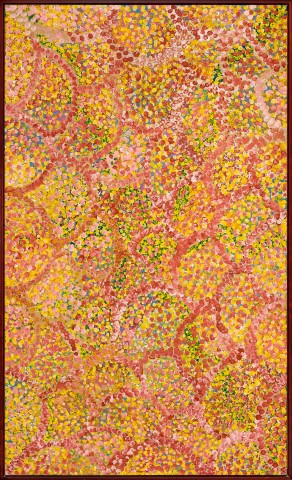Yam country, 1993
Emily Kam kngwarreye
synthetic polymer paint on canvas
151.0 x 91.0 cm
bears inscription verso: artist's name and Delmore Gallery cat. 93A07
bears inscription on label verso: Yam Country / January 1993
Commissioned by Delmore Gallery, via Alice Springs, Northern Territory in 1993
William Mora Galleries, Melbourne
Applied Chemicals Collection, Melbourne
Deutscher and Hackett, Melbourne, 29 November 2007, lot 32
Private collection, Sydney
Deutscher and Hackett, Melbourne, 22 October 2011, lot 9
Private collection, Melbourne
Of My Country: Emily Kame Kngwarreye, The Applied Chemicals Collection, Bendigo Art Gallery, Victoria, 1 May – 30 May 1999, and touring to: Hamilton Art Gallery, Victoria, 4 June – 10 July 1999; Swan Hill Regional Gallery, Victoria, 16 July – 22 August 1999; Wagga Wagga Gallery, New South Wales, 27 August – 19 September 1999; Mornington Peninsula Regional Gallery, Victoria, 28 December 1999 – 2 February 2000; George Adams Gallery, Victorian Arts Centre, Melbourne, 31 March – 30 April 2000
This painting is accompanied by a certificate of authenticity from Delmore Galleries, Alice Springs
Celebrated for her vibrant and colourful paintings based on the ever-changing desert landscape in her father and grandfather’s Country of Alhalker, Emily Kngwarreye was deeply rooted in the Anmatyerr land of her ancestors, to whom she paid respect through a lifetime of ceremonial song, dance and painting. Her art chronicled on canvas this triangular-shaped country where Emily was born in 1910, the youngest of three children, and where she lived in the ways of the eastern Anmatyerr.
When the borders of the Utopia pastoral lease were drawn across their lands in 1926, the traditional life of the Anmatyerr and Alyawarr people was disrupted. Over the ensuing decades, local people including Kngwarreye, lived a traditional life combined with intermittent work on the emergent pastoral stations. In 1977, Emily was introduced to batik as part of adult education classes held on Utopia Station and rose to become the most senior member of the fledgling Utopia Women’s Batik Group. Ten years later, in 1988 – 89, Kngwarreye painted her first work on canvas, initiating a meteoric and well-documented rise to fame.
Stylistically, Yam country, 1993 echoes a number of remarkable earlier paintings executed in 1990 and 1991. Notably, it was created in January of 1993, during a summer which was memorable for below-average rainfall and shortage of water across the country – with the drought felt particularly keenly in the Simpson Desert and Central Australia regions including at Utopia, a land characterised as a broad, flat area of desert covered by windswept sand hills and little vegetation. Offering a bright, joyous celebration of this land’s resilience, Yam country focuses upon the imminent burgeoning of the yam seed, the bush potato from which Kngwarreye derived her name. The underlying graphic matrix of meandering lines mirrors the subject – the rhizomatic roots of the Anwerlarr (the pencil yam, Vigna lanceolata) – painted here in bold red lines and semi-covered by superimposed dotting and broad stippled blotches that systematically weave across the surface of the painting. Occupying a unique transitionary place in the development of Kngwarreye’s technique with disparate compositional and stylistic devices coexisting on the one canvas, indeed the work represents an apt symbolic expression of the swift seasonal changes about to animate the desert landscape of the artist’s country.
As Janet Holt states in the accompanying certificate of authenticity, ‘It is often an important ceremony that is triggered by the nature and/or timing of the season that provokes Emily’s memory and lasting emotions. In this case, she has painted following summer rains that are accompanied by the annual ceremonial season. She also believes that through ceremony (‘awelye’) and her belief in the power of the desert, she can help provoke the desert’s hidden energy into a new and bountiful season, and consequent crop of bush tucker.’
Nearly three decades have passed since Emily Kngwarreye died in September 1996, yet her name remains synonymous with the best of Australian Indigenous art. An original, intuitive and often enigmatic artist, her painting career lasted less than a decade, but the critical acclaim for her prodigious output has only burgeoned in the years subsequently and today she is recognised internationally as one of the most important contemporary artists of the twentieth century.
CRISPIN GUTTERIDGE


